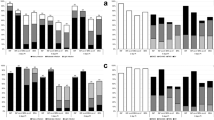Abstract
In the present study, we investigated the development of Leishmania donovani promastigotes in Aedes aegypti. Infection rate in the mosquito averaged 53%. Promastigotes were limited to the hindgut where they appeared on day 4 post-infection. Massive multiplication of promastigotes occurred between 6 and 17 days post-infection. The mosquito pylorus and rectum had the highest concentration of promastigotes. A maximum life span of 20 days was observed for L. donovani promastigotes in the mosquito. Morphologically intact L. donovani promastigotes were ejected with A. aegypti faeces, following a blood meal. Implications of the development of Leishmania spp in the mosquito host are discussed.
Résumé
On a étudié la croissance des promastigotes de Leishmania donovani ingérés par Aedes aegypti. Le taux d’infection dans le moustique a pris la moyenne de 53%. Les promastigotes se trouvaient uniquement dans l’intestin postérieur; ils s’y sont manifestés le quatrième jour après infection. Les promastigotes se sont beaucoup prolifères entre six jours et dix-sept jours après contamination. La concentration de promastigotes la plus épaisse a eu lieu dans la région rectale du moustique. On a enregistré 20 jours comme la période maximum de survie des promastigotes de L. donovani dans le moustique. Après un repas de sang, des promastigotes de L. donovani ont été émis, morphologiquement intacts, dans les feces d’ A. aegypti. Les implications de la croissance de Leishmania spp dans cet hôte—le moustique—sont discutees.
Similar content being viewed by others
References
Bennet G. F. (1970) Development of trypanosomes of the T. avium complex in the invertebrate host. Can. J. Zool. 48, 945–957.
Kaddu J. B., Mutinga M. J. and Nyamori M. P. (1986) Leishmania in Kenyan phlebotomine sandflies—IV Artificial feeding and attempts to infect six species of laboratory-reared sandflies with Leishmania donovani. Insect Sci. Applic. 7, 731–735.
Molyneux D. H. (1977) Vector relationships in the trypanosomatidae. Adv. Parāsit. 15, 1–82.
Molyneux D. H. and Ashford R. W. (1983) The biology of Trypanosoma and Leishmania Parasites of Man and Domestic Animals, Taylor & Francis Ltd., London.
Schlein Y., Warburg A. and Yuval B. (1986) On the system by which sandflies maintain a sterile gut. Insect Sci. Applic. 7, 231–234.
Service M. W. (1980) A Guide to Medical Entomology. The Macmillan Press Ltd., London.
Wenyon C. M. (1911) Note on the occurrence of Her- petomonas in the Phlebolomus of. Aleppo. J. Lond. Sch. Trop. Med. 1, 98.
Author information
Authors and Affiliations
Rights and permissions
About this article
Cite this article
Mutero, C.M., Mutinga, M.J. & Omogo, D. Development of Leishmania spp in Mosquitoes—I. Experimental Infection of Aedes aegypti with Leishmania donovani promastigotes. Int J Trop Insect Sci 9, 453–456 (1988). https://doi.org/10.1017/S1742758400010948
Received:
Revised:
Published:
Issue Date:
DOI: https://doi.org/10.1017/S1742758400010948




